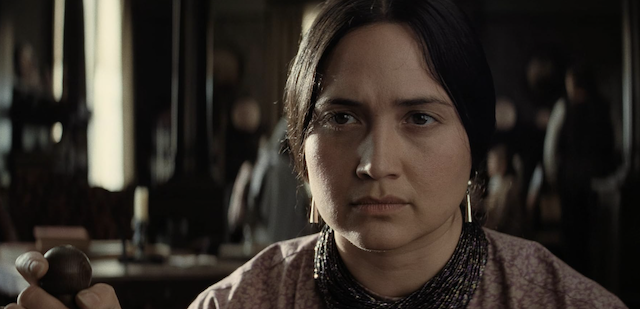
Lily Gladstone, ©Melinda Sue Gordon/Apple Original Films
Killers of the Flower Moon : Based on David Grann’s broadly lauded best-selling book, “Killers of the Flower Moon” is set in 1920s Oklahoma and depicts the serial murder of members of the oil-wealthy Osage Nation, a string of brutal crimes that came to be known as the Reign of Terror.
Rating: R (Some Grisly Images|Language|Violence)
Genre: Crime, Drama
Original Language: English
Director: Martin Scorsese
Producer: Martin Scorsese, Dan Friedkin, Bradley Thomas, Daniel Lupi
Writer: Eric Roth, Martin Scorsese
Release Date (Theaters): Wide
Release Date (Streaming):
Box Office (Gross USA): $68.0M
Runtime:
Distributor: Paramount Pictures
Production Co: Apple Studios, Appian Way, Imperative Entertainment, Sikelia Productions
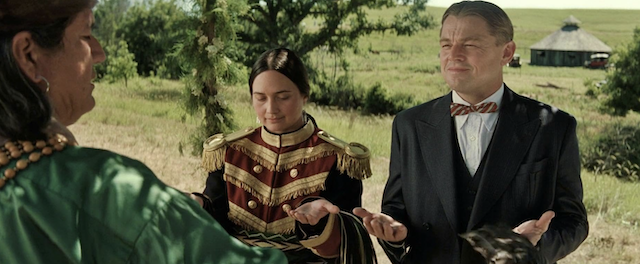
Lily Gladstone, Leonardo DiCaprio, ©Melinda Sue Gordon/Apple Original Films
Q&A with Actress Lily Gladstone
Lily Gladstone: Like you said, “The door is open.” Recently, in the New Yorker, my friend Sarah Harjo and I talked about recently, the concept of how, when you kick the door open, maybe it’s your responsibility to stand there and hold it open. It feels like it’s circumstantial because of the film, the history behind it, the filmmaker, and the timing. It’s certainly not because of a lack of incredible talent and performances over the years. It’s something else that I said recently.
A lot of times, when people hear me speak about where I come from — about culture, language, whatever — it’s easy for your ear to hear me say I was talking about different peoples. I know that culturally, a lot of people’s ears need to catch up, perceptions need to catch up. I feel like we — indigenous people — have had a bit of a renaissance in representation recently, thankfully so. But since people’s perceptions are catching up, maybe taking notice of some things has been a bit easier to put in the periphery even when there’s nominations. It feels circumstantial, but that doesn’t mean it’s not a big responsibility. It also doesn’t mean I’m not incredibly grateful. I am taking it day by day.
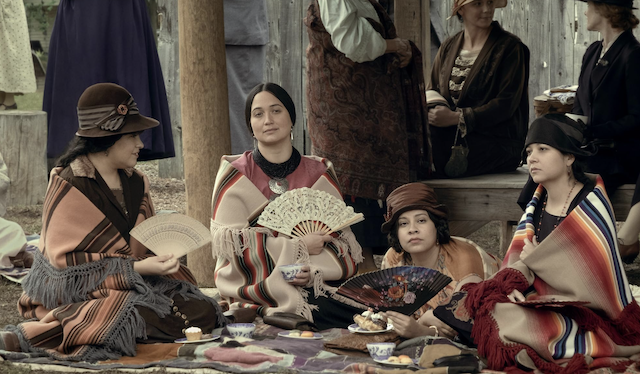
Four Osage sisters (played by, from left, JaNae Collins, Lily Gladstone, Cara Jade Myers and Jillian Dion), ©Melinda Sue Gordon/Apple Original Films
Q: You’re from the Blackfeet Nation, but you’re playing an Osage woman. How was your upbringing helpful for you to understand Mollie? It’s a different culture, but did you see parallels in it, especially when you were digging deep, learning the language and cultures, what were some of the helpful things for you that you brought out of yourself?
Lily Gladstone: Culturally, Osage and Blackfeet share some things being plains tribes. The Osage were relocated to more of a plains area and have always held that in their territory, in their hunting territory, ancestrally anyways. They’re also woodland people. But they have very different histories. Culturally is one thing. The historical relationships with the United States government — with settler colonialism — there are resources, a lot of resources in Montana that some Blackfeet have, a lot of ours have to do with surface grazing rights, and that’s been a big thing for us with trying to replace buffalo on our plains with cattle. But a lot of people’s livelihood is surface grazing, mineral development. We’ve long protected the sacred space from gas development.
I grew up close to Glacier National Park, as it’s known, which is Blackfeet territory. Even though our territories have dwindled down significantly to the reservations that we’re on now — the reservation of the states and the reserves in Canada — we weren’t a relocated people, we’re still on our ancestral lands. The Osage were relocated. Different world views emerged, different cultural tenants emerged, and that really influenced the way that Mollie would metabolize and process a lot of her grief.
The idea of the river doesn’t go backwards, it only goes forwards. You don’t dwell on things. It was a lot of the cultural conversations I was having with Osage folks, [that] Mollie was the first generation born in Oklahoma after relocation had happened. She was raised by a family that had gone through the trauma of that and had embraced the setting aside or the burying of a certain way of life because things had changed.
There were some elements in the script that were definitely within Osage oral tradition — practices at the time that aren’t necessarily practiced now. That also helped like when Rita and Mollie and this third woman played by a community member, Margaret Sisk, after Lizzie Q, our mother passes away, we’re wailing. Osage wailing was a common practice to mark grief. After you have your time to get it out of your body, to grieve loudly for their spirit, to hear you calling [out to] them, sending them on their way — then you just pick up and move on. There’s not a lot of time to sit in grief. You have to just continue forward.
Culturally, that’s what a lot of Osages were dealing with, this transition of time. The idea of wailing isn’t practiced anymore, but is still very much known about and talked about as a tradition. What has taken its place? I didn’t really plan it, but after I watched the film, I realized that Mollie and her sister Rita were maybe some of the last generation to wail. And when Rita passed, the response that found me on that staircase, the scream, that scene was scripted to be… It was supposed to be a slow punch in on Molly’s face with a voiceover over the top as the realization was settling in that it was Rita. But that’s not what came out.
That was our first take in a wide shot. That was just an establishing shot, and Marty was trying to solve with Rodrigo how we were going to move a dolly down the staircase to punch in on my face. But then that’s what came out. I think, maybe on the day, but definitely later when I watched it, I was like, that’s an interesting bookend, a shift of culture. There’s a lot of things that were very specifically Osage that I had to pick up and integrate into the fiber of Mollie that’s definitely not culturally embedded in the Blackfeet.
Then the other elements being, even though there was a commonality, we had with my great, great, great grandmother Lily, who I was named after — my dad’s grandmother. She was born around the same time as Mollie. They were born 10 years apart from each other. Both traditional women spoke their language fluently and witnessed this change in the end of the Buffalo days, as we would call it. But then there’s also a really deep embrace of Catholicism.
That was another element of being in Oklahoma in the Bible Belt. I remember the way that there’s the worldview down there; there’s similarities to be found. The relationship with sex plus one of the atheism is also very specific to how Mollie was seeing what was going on around her. A lot of the references that Marty would make as Catholicism is a huge theme in a lot of his work as well — the idea of absolution and forgiveness of these black and white sort of [things] — either you’re right or they’re wrong sort of thinking. That also influenced a lot how Mollie would process what was going on around her.
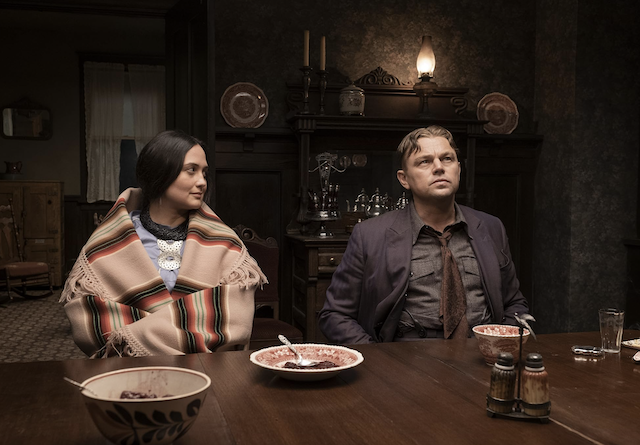
Lily Gladstone, Leonardo DiCaprio, ©Melinda Sue Gordon/Apple Original Films
Q: You crafted Mollie in this incredible, powerful and observant way. The dynamic that you had with Leonardo DiCaprio was this unclassifiable relationship. On one hand, you would see him as a villain, but every now and then, traces of love show up, and then it disappears. It’s a very complex relationship. How did you approach it; how did you and DiCaprio craft it together?
Lily: It was one of the things that helped me the most in understanding, in a new way, the whole story. Suddenly, it just clicked and made sense. When I was learning the language with my teacher, Christopher Cote — several months before getting the set — he kept teaching me Osage or exposing me to Osage the way that he does with kids who are learning it. He’ll tell them a story in Osage first, and then translate it. You can hear how to be expressive in the language that’s being made.
Blackfeet and Osage are very different languages. I didn’t want to give Osage a Blackfeet accent. But when I was listening to Chris tell these stories, he kept choosing what felt like a prescriptive way of talking about these stories to other people. There’s something about him that’s like, in the reading of this particular story — this story that I was sharing with you — he kept telling me he told me about this Coyote and Trixie story.
When I was hearing them, I kept hearing Ernest. I kept seeing this dynamic between this one-story of Coyote and whirlwind, this courtship that Coyote and Trixie had with whirlwind. There’s also an oral tradition picture down south. I know Chaka, who we’re close by, is the location of the whole history. She was an abused woman that came back in the form of a whirlwind and seeks an end to some bad men. There was this story of Coyote trying to court the whirlwind and she kept saying, “No, no, no, no.” He kept trying all these different tactics. Then she just decided, all right, if you want to be with me so bad, then she picks him up and is fluttering around, spouting out again.
I heard that story, and I’m like, “Oh, that’s how Mollie perceives herself in light of Ernest.” He’s very identifiable with Trixie and the way that he behaves, some of that ended up being in the script. Occasionally, he does something to go off, too. With these trickster narratives, they’re imperfect heroes. When you hear these trickster stories growing up, they’re funny. This particular trickster is the one that’s kind of at the top because Osage has many. There are some that are more sinister and calculated than others. We decided that Lord of the Tale would have been more like their raccoon figure, who’s just not evil. Tyree’s the one who’s very self-serving, pleasure-seeking, hedonistic — all of it. In that first scene it was already written out where Ernest was just complaining, it’s like, “Yeah, I was making a party at night and sleeping all day. I sure do love money.” Molly’s hearing that very familiar figure.
It also gave me a way of contextualizing what their relationship and dynamic was. Suddenly, I had a huge blind spot that Molly would have, that Ernest could hide in, that she felt like she had his number — had it figured out — knew the story and grew up hearing the story. In these stories, Coyote never really wins. The heroine in the story or the other people in the story, [they’re the] ones who come out on top. But as you age, the trickster stories that you heard as a kid, they’re really funny and you remember them. They’re highly entertaining.
One of my first little plays I did at school was a trickster story and the kids loved it. Then, as you get older, you realize there’s really meaningful, world-shaping lessons in them. I’m just so resistant to label this a Western. Like every time Marty and I have been in a talkback and that’s come up, he kind of looks at me like, “Oh my God, there’s that again.” I would joke with him on set, “I think maybe this is a new genre, Marty. It’s like a trickster-noir.”
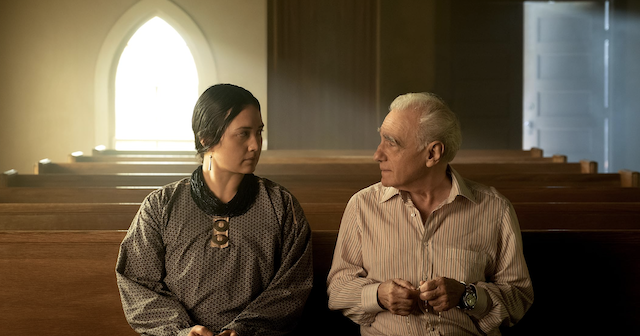
Lily Gladstone, Martin Scorsese, ©Melinda Sue Gordon/Apple Original Films
Q: There’s things like the film “The Heiress,” those graphic gaslighting stories.
Lily Gladstone: Those kind of films sit in this age of cinema that our typical filmmakers find access points to today. We want cleaner narratives. We want more commercial narratives. But these complex characters — and that was one of our biggest references — were in William Wyler’s “The Heiress” and in the relationship that Olivia de Havilland had to Montgomery Clift’s character. That was a major source of inspiration for me.
First and foremost, creating Mollie was the way that the Osage nation was telling me she was. Nobody remembers Mollie who lives today. There’s one story that survives of her blowing tobacco smoke in her son’s ear to demonstrate the traditionalism and this caring mother, but people don’t remember her. She was a construction, largely of what people had to say about their grandmothers from that generation, spending time with her granddaughter because those things are inherited. The other emulation that I felt tasked with was this leading lady from old native cinema that native women have been excluded from. My grandma grew up watching that era of cinema, finding all the costume jewelry, doing her hair a certain way, seeing herself in that sort of light, like Elizabeth Taylor. But we were never that in that age of cinema. This is a restoration of a native woman in a leading lady role.
It was a really fun opportunity to envision it because Olivia de Havilland was raised in this very oppressive, patriarchal family; her father, in the first five minutes of the film, was telling her that she’s ugly, that she’s un-weddable — she’s too plain. She has a very diminished sense of self, with no control over herself or over her destiny really, which Mollie, to a degree, had with the guardianship program — of not being able to manage her own finances. But where Olivia de Havilland’s character has a certain sense of self that Montgomery Cliff’s character has been able to manipulate and sweep off her feet — making her feel beautiful — I felt that that wouldn’t have been an access point for Mollie. With Osage people, to have a girl is hugely celebrated — like in a lot of rural cultures.There’s people that are awaited in the Osage [culture] and just feel so gifted when a girl is born. So a family of four sisters is a blessed family. They’re very precious.
Mollie’s Osage name is God Blesses Her. It was her sense of herself that was embedded in her by her community, by a natural, local society where women own everything. They’re the ones who decide how money is spent, who owns the home, owns all the goods in it. The Osage — while they’re a patriarchal society in the sense of family inheritance — they’re natural, local, meaning that the men with their name, with their clan-ship, go and live with the women. The women own everything materially. So that was another big blind spot that Ernest could hide in. Mollie had a very strong sense of self. She chose him because it was a benefit for her to have a simple white husband that would sign her checks. By and large, but especially with Osage in this film, with the guardianship program, you couldn’t make your own choices with your money. You had to have a white guardian appointed to you and it was a benefit to a lot of Osage people that that guardian be their spouse.
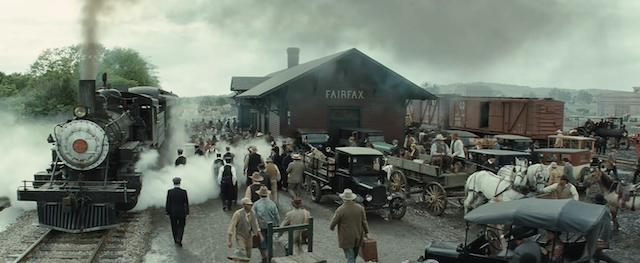 Fairfax Scenery, ©Melinda Sue Gordon/Apple Original Films
Fairfax Scenery, ©Melinda Sue Gordon/Apple Original Films
Q: Among the many devastating scenes is the one towards the end, between Molly and Ernest, when there’s finally a confrontation but a quiet one. To get to that really emotionally-hyped moment, you demonstrated a natural progression of the character in your performance. How did you reach that moment? What can you tell us about filming such a scene that’s extremely powerful and one of the best scenes of all time?
Lily Gladstone: I agree. When I saw that one written, I was so grateful that there was room to play it in a way that every actor salivates over, a re-watchable scene. I have my own view of where Molly was at that point and what her objective was since basically she got better, when she went to the hospital. Physically, that was one thing I was working with. It was one of the last things we shot. The very last scene that we shot was me and Leo re-meeting after Molly came out of the hospital and was on the plane.
There were several [scenes] that we had to shoot out of order. It’s a testament to how fantastic the script was that we were handed it because it was easy to pick up the arc wherever we were at. Early on, it was a little more difficult when we had to move the scene from the third act where Ernest was telling Mollie that Henry Roman’s dead. That’s when we had to pick up and suggest it was in order to control itself. That’s what we did. That one has been moved up in the timeline. It’s like Leo and I had only just shot the first date scene, the dance scene, which is bigger than that, the car scene, and just a couple of other things around the house because that was the location we were at.
That one we were trying to save for later on because we hadn’t fully cracked how we were going to get inside of this impossible love story at that point. That scene — go figure — ended up being like Take one or two that was used. But we spent all day on that scene because we didn’t know how we were going to get to that point yet with all the other stuff. There were versions where we were a lot more combative with each other, where there was a lot more suspicion on Mollie’s part, a lot more guilt on Ernest’s part.
Ultimately, though, the way it was fixed in the script — and it was written so well — that the writing was what carried it. We did end up finding the relationship back in the studio, shooting footage after watching the dailies, that we were working with an authentic love story between the two. We ended up winging that. That last scene was fairly in sequence, but it honestly wasn’t that much different than the first time Leo and I reversed it together in our first two weeks there. It was so well written.
At that point, for Mollie, what else is there left to lose? There’s absolutely nothing left to lose. We shot that a few different ways, but I was pretty certain what the shape would be. Marty was really keeping it very close and, eventually, as you see in the film, very close to the page. I was also not fully convinced that some of our improvs early on — whether there was a little more suspicion on Molly’s part or a little bit more all of that — there were a couple of times where I would get up and leave right away. I wasn’t quite the right tone for sitting with it. It was really weird. If anybody’s still watching or coming in, if you’ve made up your mind about how Molly’s feeling about Ernest in the end, I would be curious if you rewatched it and see what your perception was of the performance.
 Robert De Niro, Leonardo DiCaprio, ©Melinda Sue Gordon/Apple Original Films
Robert De Niro, Leonardo DiCaprio, ©Melinda Sue Gordon/Apple Original Films
Q: This was a genuinely local production with a lot of the local Osage people as advisors. How did that enable your performance, giving you the comfort and confidence level that you needed to embody Molly? Talk about working with Julie O’Keefe, the costume designer, who was also Oscar-nominated. She was the head Osage wardrobe consultant and took care of every single detail of the costuming. That was probably empowering and also a confidence booster in the way that you became Mollie.
Lily Gladstone: Yeah, absolutely. It happens so often that when you’re cast as a native actor in a native role in a film, which is a period piece, you’re the only one cast or crew — or maybe if you aren’t the only one in the cast — you all come from different nations, you have different perspectives. It was essential and important that there were always Osage people present. Having Julie there to advocate for what was authentically Osage dress, there’s an element of it where you can hear that and look at it like a collector. It’s like, “Oh, is this really authentic? What’s the era?” There’s that not superficial at surface level authenticity.
Beyond that, there are stories that are embedded in how Osage women dress, and costumers, creatives get creative and it gets fishy when you start getting creative with a culture that’s not your own and that’s where we start getting some really messy appropriation or representation. Even the most well-meaning folks can stumble into stuff without meaning to. It was really essential that it was Julie and that, on any given day, there were Osage women on set to help place my blanket on me, to advocate for when I would insist that Mollie’s not in her guardian’s office and she’s the one of her sisters who held to tradition.
I know they’re gorgeous shoes, but it would be a moccasin scene — just little things like that. Jackie creates a wardrobe. She’s got such a beautiful, refined, artistic taste, but she also does it all because she knows it services the character. The more embedded you get in the character as the actor, the wardrobe has so much to do with it. Jackie gave all of us pieces to play with.
Mollie had the least room to play with in terms of modern fashion, but when she was wearing modern fashion, she would wear it in a very Osage way. You also got to see a little bit of that diversity expressed in her sisters. Her sisters embraced modernity more than she did in some ways. You see that particularly with Anna. It’s like Anna is in very flapper clothes. I really loved that it was a story that was able to be told, too, because, in its inception a hundred years ago, it’s great when people stereotype who native people are.
People have such a narrow view of who we are. If we’re out in society and we’re not in beads and buckskins, do people really recognize us as being native? It’s a legacy that’s definitely been created and curated by Hollywood so it’s really refreshing in this collaboration between Julie and Jackie [West], and the Osage women around me constantly on set.
I knew that, and I’ve been told several times in Osage country, that if people are fussing over you [that’s one thing]; if they’re leaving you alone, not talking to you, you’re basically shunned. It’s like, don’t take it personally if you got all these Osage women running up to you and tugging at your blanket and fixing things on you, telling you you’re not wearing it right. It’s not because you’re an outsider, necessarily — it’s because you’re being brought up on the inside. If you go to a launch event, you get all the moms and aunties constantly fixing how their daughters are wearing their blankets and their beads are falling a certain way.
Also, it was a really refreshing thing for a lot of our non-native crew to see that Indians, if we like you, we tease you. That shaped how that whole scene between the sisters was rewritten — when the four of us sat down together and wrote that scene. We had been in language lessons along the way, and figured out how to create our own language in English that would easily translated to Osage. The four of us, even though our characters were based upon the birth order of Osage girls, that’s part of being in Indian country too.You hear the same lesson over and over again from everybody. So you have to accept it every time. Like, “Oh, yeah, I didn’t know that.”
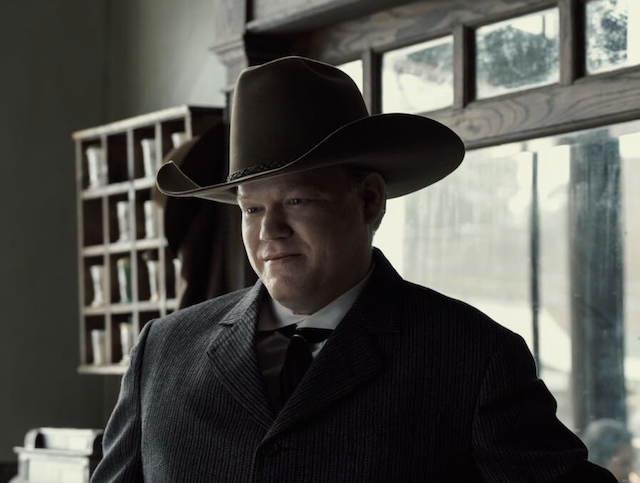 Actor Jesse Plemons, ©Melinda Sue Gordon/Apple Original Films
Actor Jesse Plemons, ©Melinda Sue Gordon/Apple Original Films
Check out more of Nobuhiro’s articles.
Here’s the trailer of the film.

